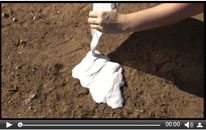Are you having trouble viewing this email? View it online here: www.crime-scene-investigator.net/newsletter/0415.html This message
was not sent unsolicited. You signed up for this newsletter. If you wish to unsubscribe see the instructions at the bottom of this message.
|
|
||
|
APRIL 2015 | ||
|
Welcome to the April 2015 Crime Scene Investigator Network Newsletter
| ||
|
This Month's Featured Resource on the Crime Scene Investigator Network Website | ||
|
Best Practices For Seizing Electronic Evidence, v.3 U.S. Department of Homeland Security This third edition of the Best Practices for Seizing Electronic Evidence was updated as a project of the United States Secret Service and participating law enforcement agencies. A working group of various law enforcement agencies was convened to identify common issues encountered in today's electronic crime scenes. <View the Pocket Guide> |
||
|
Featured Video Presentation
|
||
|
Learn the basic technique for casting footwear impressions. |
New CSI and Forensic Job Announcements
|
|
|
The most comprehensive listing of Crime Scene Investigation and Forensic To be notified of job openings as they are posted, follow us on Twitter: Job Posting Alerts |
||
|
Crime Scene Specialist
Tucson Police Department, Arizona, USA Final Filing Date: April 12, 2015 Salary: $16.79 - $26.64 per hour Documents all types of crime scenes for the recognition, collection and preservation of physical evidence including latent fingerprints, body fluids, hair and fibers, weapons, and other materials in sometimes stressful and unpleasant environments. Photographs and/or diagrams crime scenes, physical injuries, victims, evidence, and postmortem examinations. Analyzes, collects, packages, and preserves evidence. <View complete job listing> |
||
|
Forensic Scientist I, Digital Evidence
North Carolina Dept of Justice, Raleigh, Greensboro, and Asheville, USA Final Filing Date: April 9, 2015 Salary: $42,667.00 - $69,177.00 Annually This is entry level professional forensic analysis work that requires the analysis of forensic evidence in a crime laboratory setting. Employees examine and analyze evidence from simple to moderately complex casework, make judgments and testify in court as necessary to explain and defend their findings. <View complete job listing> |
||
|
Criminalist — Biology
Oklahoma State Bureau of Investigation, Edmond, Oklahoma, USA Final Filing Date: April 13, 2015 Salary: $49,901.94 per year This is the entry level where incumbents train to perform forensic analysis, and perform some limited supervised casework. All aspects of assigned tasks are clearly defined and all work is technically and administratively reviewed during performance and upon completion. <View complete job listing> |
||
 |
||
|
Latent Print Examiner
Miami Police Department, Florida, USA Final Filing Date: April 24, 2015 Salary: $58,002.88 - $77,898.08 Annually Develops, compares, evaluates, identifies, and prepares latent fingerprints/palm prints for court exhibits, and testifies in all courts of law as a qualified expert witness. <View complete job listing> |
||
|
Forensic Medical Investigator I
Travis County Medical Examiner, Austin, Texas, USA Final Filing Date: April 21, 2015 Salary: $42,382.08 - $52,977.60 Annually Investigates the physical and medical aspects of natural and unnatural deaths by responding to scenes or taking reports over the telephone, which will provide the Medical Examiner with a basis on which to determine the cause and manner of death. ... <View complete job listing> |
||
|
London Metro Police, UK
Final Filing Date: 17 April 2015 Salary: £35,404 plus £3,501 location allowance per annum You'll join us in our Evidence Recovery Unit where you'll be responsible for examining, evaluating and reporting forensic findings from exhibits and crime scenes. <View complete job listing> |
||
|
Search for more job listings in Crime Scene Investigations and Forensics To be notified of job openings as they are posted, follow us on Twitter: Job Posting Alerts |
||
|
CSI in the News
|
||
|
IUPUI chemist earns grant to improve drug screening in forensics
IUPUI analytical chemist Nicholas E. Manicke has received a $273,826 award from the U.S. Department of Justice's National Institute of Justice to improve the speed and accuracy of mass spectrometry for detecting drugs and poisons in blood samples. IUPUI Newsroom - March 31, 2015 International Association of Arson Investigators-Certified Fire Investigator Board Receives Accreditation from Forensic Specialties Accreditation Board Tracks Inspector simplifies digital evidence collection and analysis for law enforcement PML Helps Lead Standardization for Firearm and Toolmark Examinations ISACA Lays Out Forensics for the Data Breach Era |
||
|
Other Resources on the Crime Scene Investigator Network Website
|
||
|
Not Subscribed to this Newsletter?
|
||
|
If you are not subscribed to this newsletter, you may subscribe with this link: SUBSCRIBE via email |
||
|
To Unsubscribe
|
||
|
To unsubscribe from future e-mail newsletters, please click here: UNSUBSCRIBE Copyright ©2015 Crime Scene Resources, Inc. Crime Scene Investigator Network |



